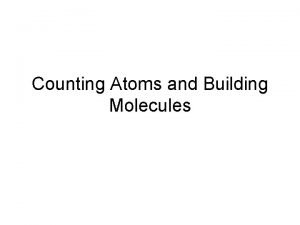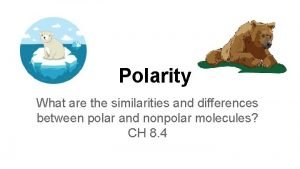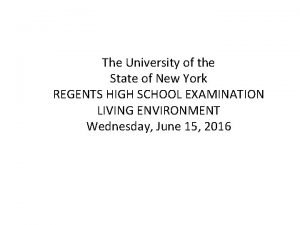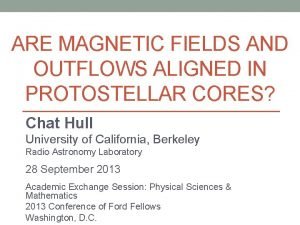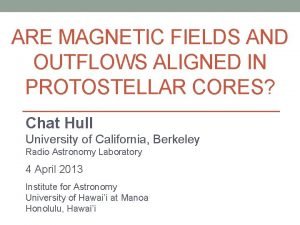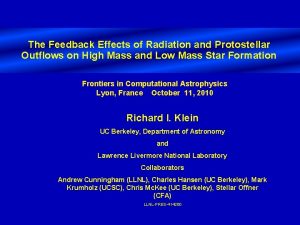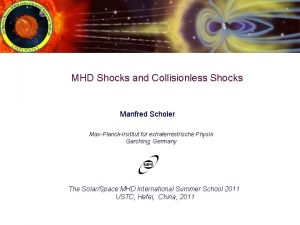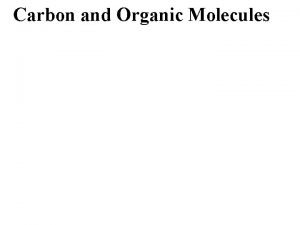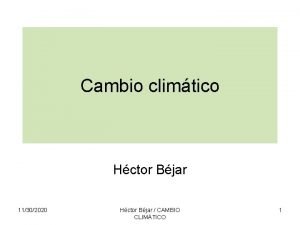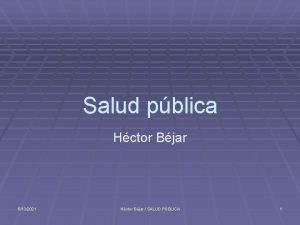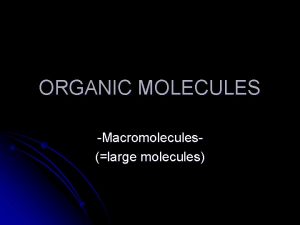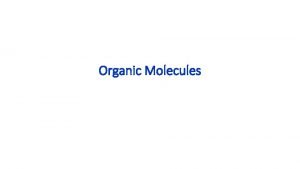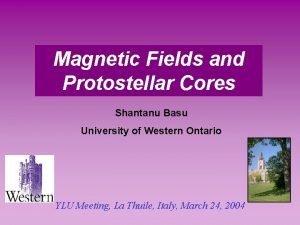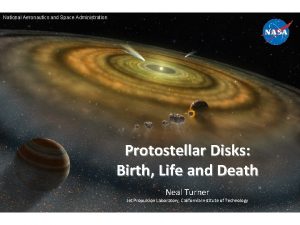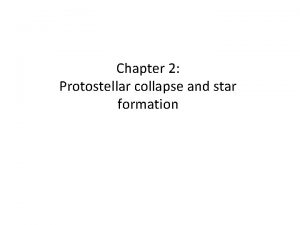Shocks and Molecules in Protostellar Outflows Hctor G



















- Slides: 19

Shocks and Molecules in Protostellar Outflows Héctor G. Arce Yale University Image Credit: ESO/ALMA/H. Arce/ B. Reipurth

Molecules in Space part of recycling of ISM Images courtesy of NRAO/AUI

Importance of multi-line observations in star-forming region / ISM Astrophysics • Different species trace different density and “kinematic” regimes • Can be used to study evolution of clouds and the star formation process. Chemistry • Needed to constraining chemical models. • Detection and identification of complex molecules in different environment (e. g. , cold clouds, PDRs, diffuse clouds, etc. ) provides critical information for understanding the possible formation (and destruction) pathways of these molecules Link to astrobiology • Some of the complex molecules found in the ISM are large organic molecules, thought to be important for the formation of molecules important for life. • It is possible that chemical processes in the interstellar medium provide the essential material that allowed the emergence of life.

Zooming in on star-forming core Figure from Herbst & van Dishoeck (2009)

Protostellar outflows: great lab for studying shock physics and chemistry Shocks trigger physical processes (e. g. , ice sputtering, grain destruction) and chemical reactions (i. e. , warm/high-temp. gas-phase chemistry) not present in quiescent gas, affecting the chemical abundance of different molecules in cloud, and helping in formation of other molecules (e. g. , Bachiller et al. 2001; Herbst & van Dishoeck 2009). Can use shocks to probe dust composition and warm chemistry probably existent close to forming star/planets outflow envelope disk Images courtesy of NRAO/AUI

Protostellar Jets and Molecular Outflow Optical emission (shock excited atomic lines) IR emission (mostly shock-heated H 2 lines) L 1551 (both trace recently shocked gas) L 1157 1 pc Bally et al. ; Stojimirovic et al. (2006) 0. 1 pc HH 212 IR image Looney et al. (2007); Bachiller et al. (2001) Contours: CO outflow emission ( λ ~ 1 - 3 mm ) low-J CO (mostly) trace entrained gas 104 AU Zinnecker et al. (1998)

Outflows in Protostellar Cluster Example: NGC 1333 protostellar cluster IRAC 2 (4. 5µm) Green image: IRAC 2 (4. 5µm) emission (Gutermuth et al. 2008) Red and Blue contours: Red- and blue-shifted CO outflow using CARMA (Plunkett et al. 2013)

Water and HCO+ in outflows Water typically traces recently shocked gas NGC 1333 protostellar cluster Water in outflow dominated by: High-temperature gas-phase chemistry: O + H 2 —> OH +H OH + H 2 —> H 2 O + H SVS 13 Ice sputtering: H 2 O (solid) —> H 2 O (gas) IRAS 2 A Possible path for increase of HCO+ in outflows 1) Release of water and CO ice from dust due to shock heating: CO (solid) —> CO (gas) H 2 O (solid) —> H 2 O (gas) 2) CO may be photo dissociated in shock, and C can be photoionized hv + CO —> C + O hv + C —> C+ + e. Green image: IRAC 2 (4. 5µm) emission (Gutermuth et al. 2008) Red: redshifted H 2 O (110 -101) Blue: blueshifted H 2 O (110 -101) [~ 557 GHz] Orange: redshifted HCO+(1 -0) Cyan: blueshifted HCO+(1 -0) [~ 89 GHz] H 2 O observed with Herschel (Arce et al. , in prep. ), HCO+ observed with CARMA (CLASSy data, Mundy et al. , in prep. ) 3) Reaction of C+ with water results in HCO+ C+ + H 2 O —> HCO+ + H

Multi-line observations of SVS 13 (HH 7 -11) outflow different species and shock chemistry can help understand outflow entrainment mechanism spectrum towards source position CO (1 -0) outflow CO (1 -0) & HCO+ (1 -0) CO (1 -0) & H 2 O (110 -001) HCO+ (1 -0) & H 2 O (110 -001) H 2 O (110 -101) CO from Plunkett et al. (2013) HCO+ from CLASSy (Mundy et al. , in prep. ) H 2 O observed with Herschel (Arce et al. , in prep. )

HCN in outflows HCN seems to trace young shocks HCN In warm temperatures HCN is produced more than HNC Green image: IRAC 2 (4. 5µm) emission (Gutermuth et al. 2008) Magenta: redshifted HCN(1 -0) Light blue: blueshifted HCN(1 -0) [~ 89 GHz] HCN observed with CARMA (CLASSy data, Mundy et al. , in prep. )

Comparing distribution and kinematics HCN(1 -0) + HCO+(1 -0) H 2 O (110 -101) + HCO+(1 -0) spectra at peak position HCN(1 -0) HCO+(1 -0) H 2 O (110 -101)

Comparing distribution and kinematics in IRAS 2 A distribution using integrated intensity maps CO (1 -0) & HCO+ (1 -0) p-v cut CO (1 -0) & HNC (1 -0) kinematics using position-velocity diagrams CO (1 -0) HCO+ (1 -0) HCN (1 -0) CO from Plunkett et al. (2013) HCN and HCO+ from CLASSy (Mundy et al. , in prep. )

Complex Organic Molecules (COMs) in outflows IRAM 30 m observations of IRAS 2 A-E 1 NGC 1333 -IRAS 2 A redshifted Arce et al. , in prep.

COMs in outflows: L 1157 -B 1 L 1157 IRAM 30 m observations of L 1157 B 1 and B 2 B 1 B 2 Looney et al. (2007) L 1157 -B 2 Arce et al. (2008); see also Yamaguchi et al. (2012) Arce et al. , in prep. τ shock ~ 103 yr indicates that complex species formed in the surface of grains and were then ejected from the grain mantles by the shock. Formation of COMs on grains in low-mass star forming regions must be relatively efficient. Arce et al. , in prep.

Detected Complex Organic Molecules in Outflows Commonly detected COMs: HCOOCH 3, HCOOH, C 2 H 5 OH, CH 3 CHO Other common COMs: CH 3 OCH 3, CH 3 CN, C 3 H 2 Less common COMs: HCCCH, NH 2 CHO, CH 3 CCH Abundances of most common COMs (preliminary results) E 1 Comparing abundances with other sources of COMs +X Low Mass C 2 H 5 OH Low Mass * HCOOCH 3 High Mass + * Figure from Öberg et al. (2011) + some data from Arce et al. in prep. CH 3 CHO CH 3 OCH 3 COMs in different SF environments seem to have formed in similar way

COMs found in outflows likely formed on dust ice surface Commonly detected COMs: HCOOCH 3, HCOOH, C 2 H 5 OH, CH 3 CHO Other common COMs: CH 3 OCH 3, CH 3 CN, C 3 H 2 Less common COMs: HCCCH, NH 2 CHO, CH 3 CCH Molecules (and abundances) consistent with formation on (CO-dominated) ice surface aided by UV and CR Evolution of ices in star-forming core Reaction scheme of CH 3 OH-based ice photochemistry Öberg et al. (2010) = HCO-bearing complex species = H 2 O-dominated ice = CO-dominated ice = only produced abundantly at lukewarm temp. (> 30 K in lab)

Future ALMA observations Investigate spatial distribution of COMs with respect to other species L 1157 Pd. BI observations of L 1157 B 1 ~3000 AU B 1 Looney et al. (2007) Benedettini et al. (2013)

COMs in solar system comets (comparing comet Hale-Bopp with ISM) Image courtesy of NRAO/AUI Plot from Bockelée-Morvan et al. (2000) with additional data from Arce et al. (2008) The abundance ratios in the cometary ices present strong similarities with those measured in ISM (i. e. , hot cores, outflows, etc. ). This seems to be consistent with formation of the cometary molecules in the protosolar cloud, or at least in processes very similar to those met in the interstellar medium. Further comparison should be made with observations of COMs in inner circumstellar envelope and disks with ALMA

Summary Outflows trigger chemical enrichment in the surrounding gaseous environment - Herschel shows H 2 O abundant in recently shocked regions - CARMA data show overabundance of HCO+ and HCN towards outflows - Multi-line observations help constrain shock models and entrainment mechanism Detection of Complex Organic Molecules in young protostellar outflows - Formation of complex molecules on grain is relatively efficient - Abundances seem to be consistent with formation on UV-exposed CO-dominated ice Results indicate that radiation from protostar is not sole mechanism that can liberate COMs onto gas phase near low-mass protostars - impact from outflow/shocks needs to be considered when studying COMs in circumstellar environment
 Deferred
Deferred What is wrong with tom robinson's arm
What is wrong with tom robinson's arm Organic molecules vs inorganic molecules
Organic molecules vs inorganic molecules Fsae shocks
Fsae shocks Shift in sras curve
Shift in sras curve What is the relationship between atoms and elements
What is the relationship between atoms and elements Classify the following unbalanced chemical equations
Classify the following unbalanced chemical equations Properties of solid
Properties of solid Substance
Substance Chiral achiral
Chiral achiral How can you count atoms and molecules
How can you count atoms and molecules Similarities between polar and nonpolar molecules
Similarities between polar and nonpolar molecules Atoms molecules and ions
Atoms molecules and ions Atoms molecules and ions
Atoms molecules and ions Atoms molecules and ions
Atoms molecules and ions Atoms molecules and ions
Atoms molecules and ions Atoms ions and molecules
Atoms ions and molecules Atoms ions and molecules
Atoms ions and molecules Farmers may someday clone
Farmers may someday clone Shape and polarity
Shape and polarity










